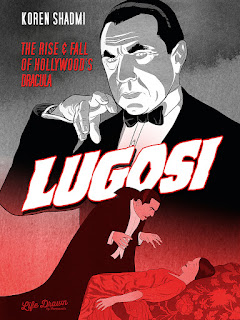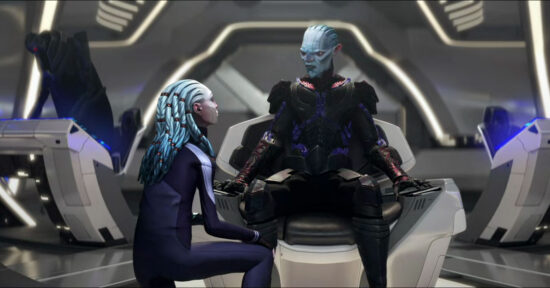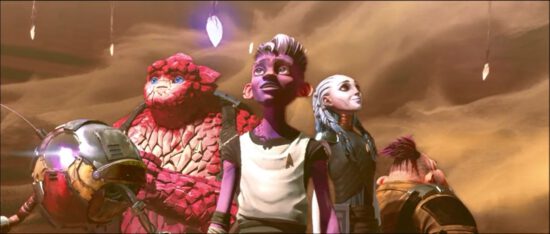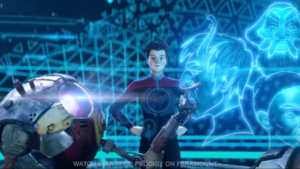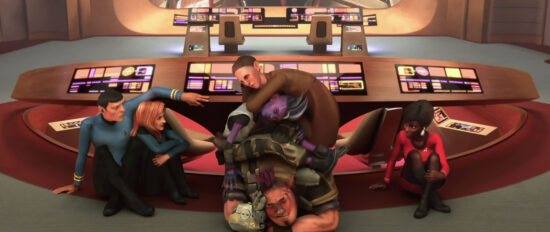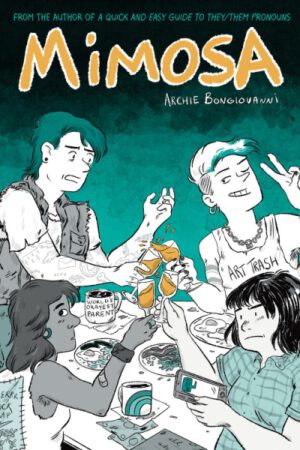I Never Promised You a Rose Garden is a world-famous 1963 semi-autobiographical novel, and the 1977 movie based on it, about one woman’s mental illness and survival. It’s also a bland 1970 country song by Lynn Anderson.
And a number of other books as well. Probably other things. Titles can’t be copyrighted; the evocative ones get used over and over again. But when they’re used for something big in the same area, a careful writer will want to make sure that any baggage from that title are appropriate, that the connotations are resonant, that the title has a purpose.
I have no idea why Mannie Murphy’s debut graphic novel is named
. But, then, there’s a lot of things about this book I don’t understand: it’s in large part a series of very specific artistic decisions that baffle me.
I want to be clear: this is at least partially a Me Problem. Murphy’s Rose Garden circles a knot of topics that are obviously very important to them, and that they deeply believe are inextricably interlinked. But I did not find the book itself made those connections clear, or told its story cleanly, or could even stay out of its own way consistently.
Perhaps the deepest issue is the place of Murphy in the book itself. This is a deeply told book, with a specific point of view, often angry, politically committed, specific and local to Portland, Oregon. But the book tells us nothing about Murphy; they remain just the voice telling this story – this story which, the book says repeatedly, is personal but will never say why or how – with a few disjointed, random facts about their life dropped in, almost by accident. There’s also a friend named “Alder” who reappears multiple times, maybe as a stand-in for this whole Portland community Murphy is trying to represent, but is never seen on the page.
So we don’t know who Murphy is. Murphy’s voice in this book wants to tell us this is all important, and that we should believe them because they know this world…but gives us no reason to rely on that voice. Worse, the voice rambles and wanders, jumping from topic to topic in a way that may be carefully planned but feels chaotic and disjointed. The occasional wrong word choice or obviously agit-prop smash cut (“suddenly, a hundred years earlier, there were racists!”) only adds to the shakiness.
We want to believe in Murphy. We want to settle in and believe this voice will tell us the truth, connect all these disparate strands into something specific. But, as the book drones on and on, we start to think it’s the comics equivalent of one of those scrawled manifestoes sent into a newspaper, making the grand case for water fluoridation being the world-controlling tool of the Trilateral Commission or that the Alien Space Bats are coming to steal our spleens.
So: what are the topics of Murphy’s Rose Garden? First, the overdose death of River Phoenix in 1993 – Murphy clearly identified with or loved the actor Phoenix was, and there’s a semi-buried note of wanting to find people to blame for Phoenix’s death throughout the book, that this needs to be someone’s fault. Related to that – partly because Murphy seems to be most focused on Phoenix in the movie My Own Private Idaho, partly because what’s most important to Murphy all of the time is how Portland anything is – is the filmography of Portland local Gus Van Sant, who Murphy seems to loathe with the heat of a million suns.
The first section of the book stays mostly focused on Phoenix and Van Sant and Keanu Reeves, the other lead of that movie, as Murphy passive-aggressively attacks Van Sant over and over again for…this is not quite clear to me. There’s a sense that Van Sant is just wrong – about the people and places of Portland, about what queer life is like, about everything and anything in the world. To Murphy, every single artistic choice Van Sant made is the wrong one and everything he did was horrible…except that Murphy is also clearly obsessed with Van Sant and his movies. There’s also an implied theory of art that needs to be correct – that some viewpoints, some stories are just wrong, and can be discarded because of that, and that the good people will obviously know which stories and themes and ideas are right and which are wrong.
Along the way, Murphy uses first names exclusively, as if these were close friends and not famous people that the pre-teen Murphy, as far as I can tell, never met or interacted with. “Gus” does this, and “Keanu” surely must feel like that, and obviously “River” is a dark, tormented, perfect, lovely soul, too good for this world. It’s all personal, as Murphy takes that tween-fan connection and bases a whole implied theory of Portland, queerness, and white supremacists on what seems to be primarily the first awakenings of sexual desire.
From that first section, Rose Garden swerves hard into white supremacy. You see, one character in Van Sant’s Drugstore Cowboy was loosely based on a locally-known Portland-scene guy, who led a hate-crime murder somewhat later and also appeared on an episode of Geraldo with a bunch of skinheads. As with many things in Rose Garden, the sequence of events is muddy – I’m never sure if this is just the way Murphy is telling the story, jumping to ideas as they come to mind, or if they’re being deliberately obfuscatory about dates that don’t line up to tell the clean story they want to be true. And, again, everything Van Sant ever did is either deliberately evil or accidentally malevolent, according to Murphy.
(Note: I don’t think I’ve ever seen a Van Sant movie; I have no dog in this fight. But it’s really, really important to Murphy.)
All of the connections in Rose Garden are on that level: things that are so blindingly obvious in Murphy’s head that they can just jump from one thing to another, leaping decades or centuries or from film criticism to racist murders and get right into the thorny messy details that an outside reader doesn’t know or recognize or, frankly, often care about.
Most of Rose Garden is about the specific Pacific Northwest manifestation of white supremacy, as seen from the outside. Looking back on the book, I’m surprised there’s no queer critique of the obvious homosocial nature of that movement: Murphy seems to think of anyone in any level of that mindset, from any time in the past two hundred years, as equally evil and culpable for all bad things, utterly unredeemable and horrible and never distinguishable as individuals. For Murphy, Portland is the epicenter of evil white people, and that’s it.
But every American city has a racist past. Every American state is based in some way on white supremacy. Every region in the US has a history of cops killing people – usually POC, usually poor, usually low-status – that stretches to the present day, and a history of those cops getting away with it. I find it really hard to believe that Portland and Oregon are vastly more so than, for example, Birmingham and Alabama. So Murphy’s arguments comes across as special pleading, at best, or, more often, as a failure to see a large picture and a relentless focus on the parochial.
Bluntly, Murphy never makes the case that this place is different. Rose Garden never shows an understanding that other places even exist, that larger systemic problems exist, that any of this is more than just personal. In the end, I came to believe that Murphy cares about these issues because this is where they live and the people they know.
And, to quote Terry Pratchett, “Personal isn’t the same as important.”
Rose Garden‘s physical form also tends to aim in that personal direction, to make it look like a scrawled personal manifesto rather than a reasoned, generally-applicable argument about the wider world. Murphy’s pages are all split, half hand-written scripty text and half blue-wash images, one big picture per page. Again, it’s personal without being specific: Murphy doesn’t give away many details of their life here. It’s all public stuff: what school they went to, the media they cared about, people in the wider world. The viewpoint is personal, but Murphy doesn’t particularize it: we never learn what kind of person Murphy is, besides the clichés of someone who really liked River Phoenix and really hated white supremacists.
So, in the end, I want to believe in Rose Garden and to agree with its stances. I mean, I am against white supremacy – I hope anyone reading this can agree with that. And it is sad when young talented people take a lot of drugs and kill themselves. But Rose Garden is confused enough, and gets in its own way so much, that’s about as far as I can go. And that’s disappointing, but I think Murphy is still a young creator – there’s plenty of time to do more, to get more specific, to tell better stories, to make a clearer case. The energy is there, the spark is clear: it just needs focus.





